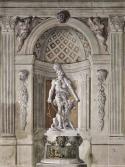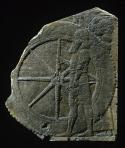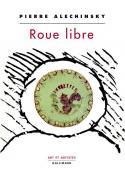Art Of The Day Weekly
#489 - from 2 November 2017 to 8 November 2017
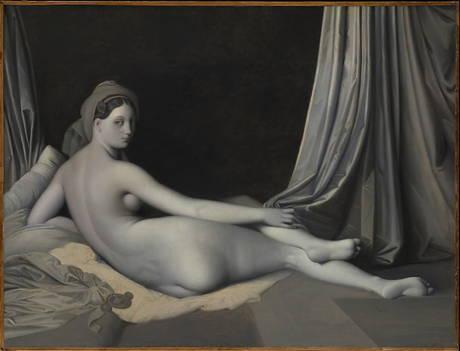
Jean-Auguste-Dominique Ingres, Odalisque in Grisaille, ca 1824-1834, 83,2x109,2 cm, oil on canvas, Metropolitan Museum, New York (exhibition at the National Gallery, London).
IN THE AIR
Should painting be in color?
LONDON – When we speak of grisaille (greyness), we usually think of a low-hung sky, of a dreary suburb, of a boring life. The term is rarely used in a positive way. Yet, when the well learned Fabri de Peiresc used it for the first time in 1625 in his Letters, it was only used to name a painting done in two colors. The National Gallery has explored this vein: the painting expressed in a minimal range. Not the cup of tea of Pop Art! How far does the habit of monochrome (or duotone, if we consider black and white as colors) go back to, and for what reasons? We can go as far back as the 12th century, when the Cistercian monks produced austere glass windows, since at the time the excess of color was linked to pleasure, therefore to sin. Later, other reasons prevailed, such as showing one’s virtue; working specifically with light and shadows; or simply to give indications to the engraver at a time when paints could be applied to prints for a better distribution. The exhibition supports its theories with masterpieces such as Saint Barbara by Jan van Eyck, going on to the avant-gardes such as Malevich, and ending in our day with Bridget Riley or Olafur Eliasson, and surprises the viewer with a Odalisque in Grisaille by Ingres. How did the champion of classic art dare tone down the incomparable skin texture of his Oriental beauty? Actually, Ingres did not produce one single odalisque in “black and white” (it is more a great number of shades of grey). He actually produced at least five – and a sixth one was mentioned during an auction in 2013)! They were all given to friends or kept in the family, like the one that belongs to the Metropolitan Museum of New York, and are all smaller than the masterpiece of 1814. But they are all of a later date - from 1817 to 1834. Ingres considered monochrome very seriously – and it still is. But today photography has become the main custodian.
• Monochrome. Painting in Black and White at the National Gallery, from 30 October 2017 to 18 February 2018.
EXHIBITIONS
A Tiepolo at Palladio’s
VICENZA – Our brave Palladio must be turning in his grave: the institution that is dedicated to him in Palazzo Barbarano, the Palladio Museum, has a name that is surely international, but somewhat out of context. It is undoubtedly easier to decipher than “Centro Internazionale di Studi di Architettura Andrea Palladio”. Would it not have been enough to say “Museo Palladio”, which tourists on their way here would easily interpret? His universal renown would be enough to serve as a palladium, to use a rare word in the right way. On the other hand, the initiative of presenting a selection of frescoes by Giandomenico Tiepolo (1727-1804) is very interesting. He was the son of the more famous Giambattista. The descendants of the patrons jealously guarded these works for nearly 250 years in their home, the palazzo Valmarana Franco, which belonged to the son of the patrician for whom the even more famous cycle of villa Valmarana ai Nani was made for. The frescoes bathe in a grisaille that echoes the exhibition in London (see above). They abandon the festive atmosphere of the garden parties so much in fashion twenty years earlier and choose instead a strict review of Palladian architecture.
• Tiepolo segreto at the Palladio Museum, as of 3 November 2017.
The myth of Nineveh
LEYDEN - 27 centuries ago it was the largest city in the world, with nearly 100,000 residents and, it is said, 15 kilometers of walls totally covered with reliefs. All its neighbors in the Middle East feared the brutality of the capital of the Assyrian empire. But today, very little remains of the city, in a district of Mosul. We must remember though that the Babylonians so wished to eliminate this threat that they leveled it down to the ground in 612 B.C. But the myth remains, and is even stronger since it was rediscovered in the middle of the 19th century. An exhibition today brings together objects that have been reassembled, such as buckets, cylinders, tablets, reliefs, and sculptures. But there is more than these material remains: the site of Nineveh gave the world a legend that goes further back than the Bible, that of Gilgamesh.
• Nineveh at the Rijksmuseum van Oudheden (national museum of Antiquity), from 20 October 2017 to 25 March 2018
AUCTIONS
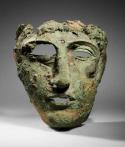
Lot 11 : Mask known as « masque de Conflans », from a Roman military helmet, I-II c., bronze , estimate: €150,000-200,000.
Montherlant, play Agamemnon for us!
The Egyptians asked to be buried with their ushebti – the scarab; the Gallic and the Etruscan lords were buried with their funerary crockery, while the Scythe warriors were buried with their horses. Henry de Montherlant (1895-1972), who enjoyed anachronisms, had asked to be buried with a superb mask of a roman warrior, called the “mask of Conflans”. A little like the noble Greek from the 16th century B.C. who was not Agamemnon, but whose tomb unearthed in 1876 by Schliemann gave a magnificent effigy in gold of the Greek hero. Archeologists were so scandalized by Montherlant’s wish that the sacrifice was not performed. In lieu, the writer took revenge of this vulgar reaction and disappeared in the form of ashes scattered over the Tiber. Montherlant’s taste for Antiquity was due it seems to his reading at a very early age of Quo Vadis? by Sienkiewicz. It was then embodied in a very personal collection, which he kept in his apartment on quai Voltaire in Paris. The wealth of the collection can be seen in this auction, with a Torso of Diana the Huntress (marble, 1st century), a Woman’s Head from the Hellenistic period, and other busts from the same era.
• Collection Henry de Montherlant, 7 November 2017 at Artcurial.
ARTIST OF THE WEEK
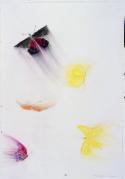
Daniel Dezeuze, Persistance du taoïsme, 2005, pastel on Canson paper, 110 x 75 cm, Galerie Daniel Templon © Adagp, Paris 2017.
Dezeuze: Supports/Surfaces, but not only
At the end of the sixties he was one of the founders of the artistic movement Supports/Surfaces, and as such produced provocative works that questioned the concept of painting, by hanging for example simple canvas stretchers on the wall. The artist, born in Alès in 1942, exploited this concept for a long time. He later also produced variations on the theme of the ladder, of the shield, and even of weapons, by assembling motley elements. But the artist cannot be reduced to this one category. Though it is difficult to recognize the same hand, he never stopped drawing, in a much more “classical” way: his vegetables, his insects are the result of a patient observer of Nature, a great user of pastels, half-way – if such a thing is possible- between Degas and Cy Twombly.
• Daniel Dezeuze, une rétrospective at the musée de Grenoble, from 28 October 2017 to 28 January 2018.
OPENINGS OF THE WEEK

FESTIVAL GAMERZ
3 November 2017 - AIX-EN-PROVENCE - Several locations
Multimedia art: how man and machine interact
BOOKS
Alechinsky rolls it out
Folk culture has a series of expressions such as to reinvent the wheel, or start from the beginning. Take the wheel as a matter of fact. Without it there would be no transportation, and a material civilization would crumble down. A philosophical system would also suffer from that: how else could we express repetition, perfection, totality? Young Alechinsky, had been influenced many years ago –almost 50 years ago – by the wheel and had started this book. It is a form of drifting of the mind, in which appear his friends and elders: Breton, Jorn, Dotremont, Folon, Walasse Ting; literary and musical interests, souvenirs of travels. The great number of illustrations – works by Alechinsky himself, popular chromes, photos of the volcano of Lanzarote, of Breton’s parrot, or of Alfred Jarry on a bicycle – appear next to a nervous and bubbly text, something like a “showcase of curiosities” which Julio Cortázar, W.G. Sebald or Orhan Pamuk also made a try at. Alechinsky, who as we know has always been attracted by writing, shows he is a brilliant man of letters.
• Roue libre by Pierre Alechinsky, Gallimard, 2017, 192 p., €24.50
IN BRIEF
MIAMI - The Bass Art Museum, founded in 1964 and dedicated to contemporary art, reopened on 20 October following an enlargement, with a retrospective dedicated to Ugo Rondinone.
PARIS - The Salon international du patrimoine culturel (International cultural heritage fair) is being held at the Carrousel du Louvre from 2 to 5 November 2017.
PARIS - Photo Saint-Germain is being held from 3 to 19 November 2017 in the art galleries of Saint-Germain-des-Prés.
TORINO – The modern and contemporary art fair, Artissima is being held at the Lingotto from 3 to 5 November 2017.

